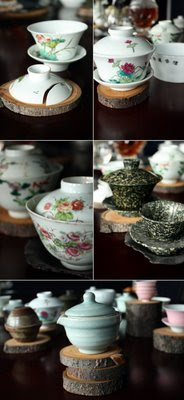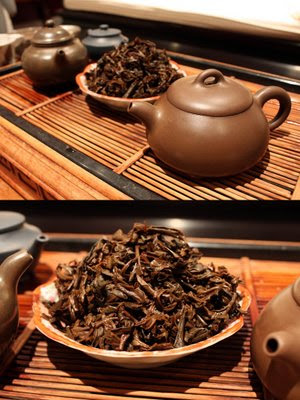She won my heart by her sacrifice. Everyone of them, shall win.... Even I don't know her name. She did whisper to us at this amazing night.
The group stayed after the session for dessert. My wife made green tea and coffee macaroons. Two aunties brought homemade mango ice-cream and angel food cake. What a feast!
We chatted and reviewed about our experiences, and our hearts were filled with content and thanks. Even though I could not pull a date and name or even origin of this puerh at the end, she did pull this "tea Moment" together.
"We must do this more often!" Betty said, "I have so much more at home, which I do not know what they are...."
As Chinese business tradition, at the end of every year, merchants among merchants give each other some of their best goods of the year, as a 'Mutual Allies Gifts'. Fortunately, Betty's family has been receiving teas as gifts. My request to her: "Bring them over, I insist." One of the Uncle then suggested, "How much do you think this one is worth?" Ahhh... the Big Chinese Question sprung. If a 50's Red Label cost around 35000 per 370 gram, and a real 100 yrs old Song Ping Ho will fetch roughly round 75000, is it safe to say this might cost around 150 per gram? Their jaws dropped and started laughing.... "I like that," betty said "Here son, this is for your retirement! And I will keep the rest of the collection for mine."
If we really think a bout it, a 1982 Chateau Petrus roughly cost around 6000, which equals to 6 glasses. 1 pot of high priced tea might produce 60+ brews and cost 1650. That's cheaper than starbucks! So, there it is everyone... another gathering will soon come? We ended around 11ish. For me, the story of this tea has just begun.
Quick boiling water fine pouring*, from chest height around the rim and lower to the center, completed a full circle pour filled up the pot. A quick immediate pour out. And again a 2nd fine pouring sealed the teapot. A ritual I learned from a good friend. This initiated the long journey to find out her true character. I shared this quick rinse with my wife before we went to bed. Act II ended.

Tea moment only happens rarely in ones life time. It's not something you can force to have: 'By faith, Not by quest.' I am truly blessed, with more than a couple of these moments had occur in my short tea life. Asking one deeply inside his passion, and to be gentle and patient is the only way to walk on the path of tea, and of course, good friendship and sincerity will lead to faith. The essence of Vintage tea is the feeling of her aging path, the history, her birth place and her true spirit. All reviewed by the chi and effect she gives to ones body and mind. How she makes you feel. A love affair perhaps....
Sunday afternoon. The sleep was as calm and satisfying as one could ask. The cha chi opens up all the knots and relaxed / refreshed the mind. Beautiful day!
She had won, Victory! Her story has passed on to 9 of us. Her love spreads, like every good teas that sacrificed themselves before.
The teapot also win : ) This had happened before:
http://themandarinstea.blogspot.com/2008/08/baby-sitting.html. First time Michael used this pot is for a 50's Red Label. The aggressive chi had gave the pot and immediate shine, almost oily and alive. As for my pot:
http://themandarinstea.blogspot.com/2006/05/my-puerh-pot.html. This was taken in 2006 (no photoshop magic) the pot used to carry a greener hue. Once after the 1st rinse of this tea, it changed to oily reddish... with a youthful glow! Nothing to do with the heat, even the next morning, the reddish hue remains.
My method of 'Detail Tasting' is simple: 'Patient and No Rush.'
1. Pour out tea from overnight or at least 12 hrs. steep. Tasting the steep slowly. (taste and aroma)
2**. Pour rolling boil water for a instant brew. Tasting the steep slowly. (cha chi)
3. Refine pour* and store in cool place without sunlight.
Some strange things happens within this 12 hrs. (Not for cooked puerh, green, yellow, light oolong and low grade tea.) The tea will only gives as much to saturate the amount of water inside the pot, but will not exhaust itself. The more strange thing is, the color and taste of the brew will be much lighter but filled with elements. 2** much darker color and fuller body, even though it is one second brew.
My wife and I were sitting on our opium bed, with toki as our carpet, of course. It is around 1ish. We poured out the 1st steep into her Korean gimhae teabowl, and started our tasting.
Her notes:
Very clear color, golden reddish.
Fragrance of flower, mineral, rock and early morning mist from mountain.
Taste of floral, sweet, mountain water, smooth throat, clean and refreshing, gramma powder.
Aftertaste of sweet tongue and back of tongue, soothing, relaxing, calm and sleepy.
His notes:
Crystal clear reddish gold of Yellow Rosewood.
Chan Hong aroma, dry pale pink rose, rock and citrus.
Smooth slide down throat to stomach, sweet to the whole mouth with minty throat, mature talcum.
Aftertaste of gramma face powder, relaxing, cooling from the chest up and refreshing, numbing to lips, clearing nasal.
Cooling, relax and happy chi. Feels like after a massage.
Toki notes:
boring parents...
Smelling the pot:
Early high mountain mist in fall. Smell of morning dew on flower. Moisturizing the nose.
2**notes:
Even on the one-second pour, the color is pale yellowish amber gold. Hot bowl of tea, but when slurp, the rush of a cooling chi travels thru the body.
Very Calming, and refreshing like drinking cold mint tea (without the sugar!)

I lit my favorite smoke paring with the tea character. My choice was 2000 epicure No.2. Then sealed the pot with another refine pour for 24 hrs. brew.
Listening to Turandot: Act III "Diecimile anni al nostro Imperatore":
Ma il mio mistero è chiuso in me; il nome mio nessun saprà! No, No! Sulla tua bocca lo dirò quando la luce splenderà!....






















































